Introduction
My new Simple Gear Test columns were born from frustration with backpacking industry standards, testing, and marketing. So I decided to start measuring gear myself. These tests might not be accurate to the nearest degree, gram, or millimeter, but they are good enough to decide if Product A meets my needs better than Product B before heading into the backcountry.
“We Don’t Trust Manufacturers’ Product Specs. You Shouldn’t Either.” – appropriate title from a Wirecutter story.
I want these tests to cover important product features, and be low-cost, easy to run, easy to understand, fast enough, and gentle enough to return gear that doesn’t measure up. I decided to begin with USB rechargeable devices.
To start off, I’ll describe general “Tips Before Testing,” then explain how I measured USB recharging for a smartphone, headlamp, satellite messenger, and battery bank.
Tips Before Testing
Here are some tips that help me choose good enough gear before testing.
- Decide which product features are important, including cost. Then mark them High, Medium, and Low priority. Focus on the High items first to narrow choices.
- Don’t fall into the trap that lightest is best. Lightest is walking naked into the wilderness. Same for most expensive is best. Even Jeff Bezos knows better.
- Good reviews should describe the reviewer’s backpacking experience with similar products. And they should cover relevant testing conditions, often including weather, location, elevation, miles (km) hiked, and feet (m) climbed.
- Be skeptical of specifications and test results coming from the company that made the product. Trust but verify.
- Even simple specs might get exaggerated, like the dimensions of a tent.
- Beware spec numbers that conveniently end in 0 or 5 – actual measurements rarely produce values that charming.
- Don’t buy expensive gear based solely on a skimpy web page with just a couple of specs plus glamor photos.
- Don’t give much credibility to customer ratings found on large retail websites. Paid postings and inexperienced users can distort those opinions.
- Purchase from companies with long-enough return windows and good-enough return policies.
USB Recharging
A larger smartphone battery might hold 3,000 mAh (milliamp-hours), while many USB battery banks claim 10,000 mAh. Unfortunately, that’s like knowing a stove canister holds 3.9 ounces (110 g) of fuel – it doesn’t tell me how long my stove will burn or how many meals I can cook.
Member Exclusive
A Premium or Unlimited Membership* is required to view the rest of this article.
* A Basic Membership is required to view Member Q&A events




Home › Forums › Simple Gear Tests and USB Recharging